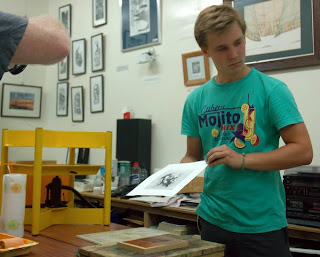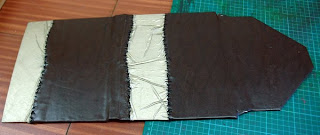
Friday, May 28, 2010
Peeling background
 Here is one of the first background prints pulled from the A4 MDF. I asked the students to try 2 sheets each of 3 different papers. First instruction was to ink up your chosen colour evenly across the whole surface. Then use the yellowXpress to print 2 copies, one at a time. Of course the first print was strong and the second print was lighter in colour and holds more textures and soft patterns on the surface.
Here is one of the first background prints pulled from the A4 MDF. I asked the students to try 2 sheets each of 3 different papers. First instruction was to ink up your chosen colour evenly across the whole surface. Then use the yellowXpress to print 2 copies, one at a time. Of course the first print was strong and the second print was lighter in colour and holds more textures and soft patterns on the surface.Drawing design
Carving MDF
Inking up
Preparing ink colour
After storm cloud
Tuesday, May 25, 2010
Russell's Bank
 Russell, Allison and Tim work on the mountain bike track at the bottom of the newly re-landscaped slope. The subsidance in heavy rain 2 years ago was a worry so the whole reinforcing, drainage, paths and levels needed pulling out and rebuilding. Twice as many, longer, poles were concreted into the ground and the heavy T and G timbers were reused. Russell and Debra are replanting the area with native trees and fruit trees before winter is over.
Russell, Allison and Tim work on the mountain bike track at the bottom of the newly re-landscaped slope. The subsidance in heavy rain 2 years ago was a worry so the whole reinforcing, drainage, paths and levels needed pulling out and rebuilding. Twice as many, longer, poles were concreted into the ground and the heavy T and G timbers were reused. Russell and Debra are replanting the area with native trees and fruit trees before winter is over.
Stabbing
Tim rubbing spine
Friday, May 21, 2010
Screenprinting
 I prepared photo emulsion on a screen using the 2 part Fotolac 49, then applied the emulsion with the coating trough. My exposure test in stages of 2 minutes for 2 to 14 minutes. Using my sunbed studio UV light box. I let the screen dry off in the darkroom then used the garden hose to wash out. Unfortunately nothing washed out so I used the waterblaster and carefully worked up the screen and was successful in the test up to the 8 minute mark. Then the emulsion was stubborn. I was very pleased with the image on the screen, it was very detailed and looked very like the 4 photograhic images (negatives) that I used.
I prepared photo emulsion on a screen using the 2 part Fotolac 49, then applied the emulsion with the coating trough. My exposure test in stages of 2 minutes for 2 to 14 minutes. Using my sunbed studio UV light box. I let the screen dry off in the darkroom then used the garden hose to wash out. Unfortunately nothing washed out so I used the waterblaster and carefully worked up the screen and was successful in the test up to the 8 minute mark. Then the emulsion was stubborn. I was very pleased with the image on the screen, it was very detailed and looked very like the 4 photograhic images (negatives) that I used.
Tims Page
 Tim has just pulled a page from the proof press. He has written, designed and set 31 x pages for his concertina book. edition of 8.
Tim has just pulled a page from the proof press. He has written, designed and set 31 x pages for his concertina book. edition of 8.
Monday, May 17, 2010
Woodtype for posters
 Students from the YMCA Holiday programme chose and set wood type to make their names and posters for their bedrooms.
Students from the YMCA Holiday programme chose and set wood type to make their names and posters for their bedrooms.
You can't beet that!
Gloria mulch
Gourds from Allison's organic garden
Sunday, May 16, 2010
Tims Schnitzel.
Melanie Yazzie visits Homeprint Book Art Studio.
 Melanie was keen to buy a set of John's imported Japanese carving tools. However John was keen for Melanie to try out his yellowXpress 5000 relief/intaglio printing press as well!
Melanie was keen to buy a set of John's imported Japanese carving tools. However John was keen for Melanie to try out his yellowXpress 5000 relief/intaglio printing press as well!
Frame fitter Tim.
Drilling A4 press bed
Squeegee time.
 The soft Akua ink is squeegeed on with picture framing card. David is careful to squeegee in both directions to ensure a nice even coating of ink into the depression before wiping off.
The soft Akua ink is squeegeed on with picture framing card. David is careful to squeegee in both directions to ensure a nice even coating of ink into the depression before wiping off.
Mopping the extra water off soaked paper.
Wiping back Solarplate.
Tim pulling print.
 Tim has just pulled a print from the yellowXpress 5000 on dampened Incisioni paper of the Gothic image.
Tim has just pulled a print from the yellowXpress 5000 on dampened Incisioni paper of the Gothic image.
Gothic print and drawing on glass.
 This drawing on the grained glass was produced by David Brebner using Stabilo 8046 pencil and Magic Colour.
This drawing on the grained glass was produced by David Brebner using Stabilo 8046 pencil and Magic Colour.The exposure for the solarplate for this print was, grained glass plate 45 seconds UV, aquatint screen 75 seconds UV, then hardened with 15 minutes UV.
Solarplate test plates.
 These 3 test plates have all had different exposures of UV light with the grained glass image first, Aquatint screen second, and hardening in the sun or UV lightbox third. The change of colour of the plates is due to the varying times each plate had in the sun. (The sun was covered by clouds after the first exposure.)
These 3 test plates have all had different exposures of UV light with the grained glass image first, Aquatint screen second, and hardening in the sun or UV lightbox third. The change of colour of the plates is due to the varying times each plate had in the sun. (The sun was covered by clouds after the first exposure.)
Gothic Intaglio Test prints
 Four test prints of each of the 3 solarplates. Dampened Incisioni paper, printed on the yellowXpress 5000 press by Tim.
Four test prints of each of the 3 solarplates. Dampened Incisioni paper, printed on the yellowXpress 5000 press by Tim.
Saturday, May 15, 2010
David draws onto grained glass.
 David is using a Stabilo 8046 pencil and Magic Black ink to draw the 'Gothic' image from the sketch book onto grained glass. This glass was grained with 150 grit silica. It is handy at the start of the drawing process to have the glass over the sketchbook drawing to pick up some of the shape and detail.
David is using a Stabilo 8046 pencil and Magic Black ink to draw the 'Gothic' image from the sketch book onto grained glass. This glass was grained with 150 grit silica. It is handy at the start of the drawing process to have the glass over the sketchbook drawing to pick up some of the shape and detail.
Tuesday, May 11, 2010
Tim from Berlin.
 Tim's first job at Homeprint gathering the autumn leaves to be placed for mulch under the fejoas. With a weeks WWOOFing in mind we hope to paint the boards for 50 new A4 presses, help with hanging 40 pieces of art at Unlimited Realities Soft Ware Company and helping move yellowXpress 5000 presses for sale.
Tim's first job at Homeprint gathering the autumn leaves to be placed for mulch under the fejoas. With a weeks WWOOFing in mind we hope to paint the boards for 50 new A4 presses, help with hanging 40 pieces of art at Unlimited Realities Soft Ware Company and helping move yellowXpress 5000 presses for sale.
Labels:
Homeprint Book Arts Centre,
organic garden,
WWOOFers
Monday, May 10, 2010
Checking the section.
Handsewing sections.
Exotic Case.
Beautiful Sections.
 Beth has completed the sewing of 3 sections, wrapped the spine with white paper about to trim 2 x endpapers to attach the sections to the case. In the photo you can see the yellow ribbon glued in the spine section to be used as a book mark. The wonderful markings on the watercolour paper has been applied by hand!
Beth has completed the sewing of 3 sections, wrapped the spine with white paper about to trim 2 x endpapers to attach the sections to the case. In the photo you can see the yellow ribbon glued in the spine section to be used as a book mark. The wonderful markings on the watercolour paper has been applied by hand!
Friday, May 7, 2010
Cleaning glass
 Clean 5 mm glass on both sides before you use it to hold down your negative over the solarplate.
Clean 5 mm glass on both sides before you use it to hold down your negative over the solarplate.Underneath we use an MDF base board, a piece of red felt, the solarplate, the negative and finally the glass. The exposure we use is 2minutes 10 seconds. This exposure varies according to the density of the negative. The darker the negative is the more time it needs.
Laying black paper over the exposed solarplate.
Pouring water onto solarplate.
 Here the warm water is poured over the solarplate to activate the chemical reaction. About 2-3 minutes is required to gently scrub the soft emulsion off the relief plate. There is a pink solution washing out and sometimes soapy bubbles. After 2 minutes wash off and apply fresh cold water to complete the washout. The pink jelly should be removed down to the yellow steel of the base.
Here the warm water is poured over the solarplate to activate the chemical reaction. About 2-3 minutes is required to gently scrub the soft emulsion off the relief plate. There is a pink solution washing out and sometimes soapy bubbles. After 2 minutes wash off and apply fresh cold water to complete the washout. The pink jelly should be removed down to the yellow steel of the base.
About 2 minutes of washing solarplate relief.
Thursday, May 6, 2010
Hanging solarplate prints to dry.
Inking up solarplate.
Subscribe to:
Posts (Atom)



































